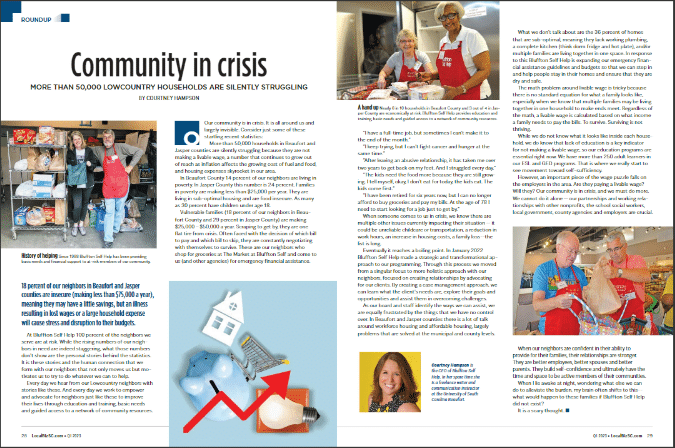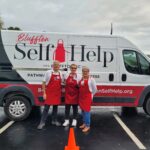Our community is in crisis. It is all around us and largely invisible. Consider just some of these startling recent statistics:
• More than 50,000 households in Beaufort and Jasper counties are silently struggling because they are not making a livable wage, a number that continues to grow out of reach as inflation affects the growing cost of fuel and food, and housing expenses skyrocket in our area.
• In Beaufort County, 14% of our neighbors are living in poverty. In Jasper County, this number is 24%. Families in poverty are making less than $25,000 per year. They are living in sub-optimal housing and are food insecure. As many as 30% have children under 18.
• Vulnerable families (18% of our neighbors in Beaufort County and 29% in Jasper County) are making $25,000 – 50,000 a year. Scraping to get by, they are one flat tire from crisis. Often faced with the decision of which bill to pay and which bill to skip, they are constantly negotiating with themselves to survive. These are our neighbors who shop for groceries at The Market at Bluffton Self and come to us (and other agencies) for emergency financial assistance.
• 18% of our neighbors in Beaufort and Jasper Counties are insecure (making less than $75,000 a year), meaning they may have a little savings, but an illness resulting in lost wages or a large household expense will cause stress and disruption to their budget.
At Bluffton Self Help, 100% of the neighbors we serve are at-risk. While the rising numbers of our neighbors in need are indeed staggering, what those numbers don’t show are the personal stories behind the statistics. It is these stories, and the human connection that we form with our neighbors, that not only moves us, but motivates us to try to do whatever we can to help.
Every day we hear from our Lowcountry neighbors with stories like these. And every day we work to empower and advocate for neighbors just like these to improve their lives through education and training, basic needs and guided access to a network of community resources.
“I have a full-time job but sometimes I can’t make it to the end of the month.”
“I keep trying, but I can’t fight cancer and hunger at the same time.”
“After leaving an abusive relationship, it has taken me over two years to get back on my feet. And I struggled every day.”
“The kids need the food more because they are still growing. I tell myself, ok, I don’t eat for today, the kids eat. The kids come first.”
“I have been retired for six years now but I can no longer afford to buy groceries and pay my bills. At the age of 78, I need to start looking for a job just to get by.”
When someone comes to us in crisis, we know there are multiple other issues currently impacting their situation — it could be unreliable childcare or transportation, a reduction in work hours, an increase in housing costs, a family loss, the list is long.
Eventually, it reaches a boiling point. In January 2022, Bluffton Self Help made a strategic and transformational approach to our programming. Through this process, we moved from a singular focus to more holistic approach with our neighbors, focused on creating relationships by advocating for our clients. By creating a case management approach, we can learn what the client’s needs are, explore their goals and opportunities, and assist them in overcoming challenges.
As our board and staff identify the ways we can assist, we are equally as frustrated by the things that we have no control over. In Beaufort and Jasper Counties, there is a lot of talk around workforce housing and affordable housing, largely problems that are solved at the municipal and county level. What we don’t talk about are the 36% of homes that are sub-optimal meaning it lacks working plumbing, has an incomplete kitchen (think dorm fridge and hot plate), and / or multiple families are living together in one space. In response to this, Bluffton Self Help is expanding our emergency financial assistance guidelines and budgets so that we can step in and help people stay in their homes and ensure that they are dry and safe.
The math problem around livable wage is tricky because there is no standard equation for what a family looks like, especially when we know that multiple families may be living together in one household to make ends meet. Regardless of the math, a livable wage is calculated based on what income a family needs to pay the bills. To survive. Surviving is not thriving.
While we do not know what it looks like inside each household, we do know that lack of education is a key indicator for not making a livable wage, so our education programs are essential right now. We have more than 250 adult learners in our ESL and GED programs. That is where we really start to see movement toward self-sufficiency.
However, an important piece of the wage puzzle falls on the employers in the area. Are they paying a livable wage? Will they? Our community is in crisis and we must do more. We cannot do it alone – our partnerships and working relationships with other non-profits, the school social workers, local government, county agencies, and employers are crucial.
When our neighbors are confident in their ability to provide for their family their relationships are stronger – they are better employees, better spouses, and better parents. They build self-confidence and ultimately have the time and space to be active members of their community.
When I lie awake at night, wondering what else we can do to alleviate the burden, my brain often shifts to this — what would happen to these families if Bluffton Self Help did not exist?
It is a scary thought.
Courtney Hampson | Bluffton Self Help CEO




Leave a Reply